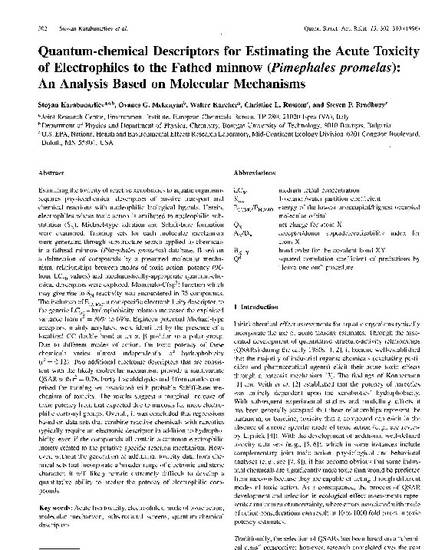
Article
Quantum-chemical Descriptors for Estimating the Acute Toxicity of Electrophiles to the Fathed minnow (Pimephales promelas ): An Analysis Based on Molecular Mechanisms
Quantitative Structure-Activity Relationships
(1996)
Abstract
Estimating the toxicity of reactive xenobiotics to aquatic organisms requires physicochemical descriptors of passive transport and chemical reactions with nucleophilic biological ligands. Herein, electrophiles whose toxic action is attributed to nucleophilic substitution (SN), Michael-type addition and Schiff-base formation were examined. Training sets for each molecular mechanism were generated through substructure search applied to chemicals in a fathead minnow (Pimephales promelas) database. Based on a delineation of compounds by a presumed molecular mechanism, relationships between modes of toxic action, potency (96-hour LC50values) and mechanistically-appropriate quantum-chemical descriptors were explored. Monohalo-C(sp3) function which may give rise to SN reactivity was encountered in 35 compounds. The inclusion of ELUMO, a nonspecific electrophilicity descriptor, to the generic LC50 - hydrophobicity relation increased the explained variance from r2 = 36% to 69%. Eighteen potential Michael-type acceptors, mainly acrylates, were identified by the presence of a localized CC double bond at an α, β position to a polar group. Due to different modes of action, the toxic potency of these chemicals varies almost independently of hydrophobicity (r2 = 0.12). Two additional electronic descriptors that are consistent with the likely molecular mechanism provide a multivariate QSAR with r2 = 0.78. Forty-five aldehydes and 3 formamides comprised the training set associated with probable Schiff-base mechanism of toxicity. The results suggest a marginal increase of toxic potency from that expected due to narcosis for more electrophilic carbonyl groups. Overall, it was concluded that regressions based on data sets that combine reactive chemicals with narcotics typically require an electronic descriptor in addition to hydrophobicity, even if the compounds all contain a common electrophilic moiety related to the putative specific reaction mechanism. However, without the generation of additional toxicity data from chemical sets that incorporate a broader range of electronic and steric character, it will likely remain extremely difficult to develop a quantitative ability to predict the potency of electrophilic compounds.
Keywords
- Acute fish toxicity,
- electrophiles,
- mode of toxic action,
- molecular mechanism,
- substructural screens,
- quantum-chemical descriptors
Disciplines
Publication Date
August, 1996
Publisher Statement
Works produced by employees of the U.S. Government as part of their official duties are not copyrighted within the U.S. The content of this document is not copyrighted.
Citation Information
Stoyan Karabunarliev, Ovanes G. Mekenyan, Walter Karcher, Christine L. Russom, et al.. "Quantum-chemical Descriptors for Estimating the Acute Toxicity of Electrophiles to the Fathed minnow (Pimephales promelas ): An Analysis Based on Molecular Mechanisms" Quantitative Structure-Activity Relationships Vol. 15 Iss. 4 (1996) p. 302 - 310 Available at: http://works.bepress.com/steven_bradbury/61/
